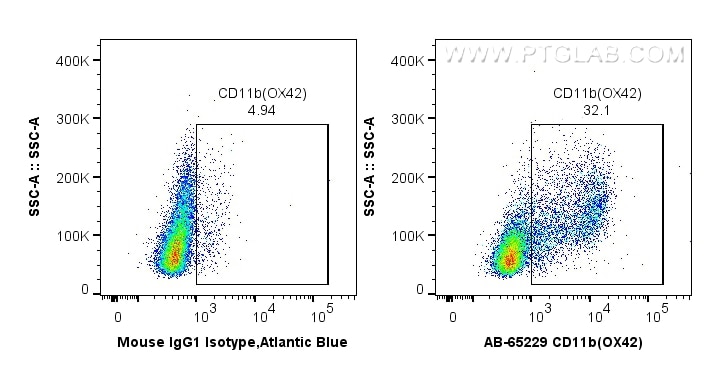Atlantic Blue™ Anti-Rat CD11b (OX42)
CD11b Monoclonal Antibody for FC
Host / Isotype
Mouse / IgG2a, kappa
Reactivity
Rat
Applications
FC
Conjugate
Atlantic Blue™ Fluorescent Dye
CloneNo.
OX42
Cat no : AB-65229
Synonyms
Validation Data Gallery
Tested Applications
| Positive FC detected in | Wistar rat splenocytes |
Recommended dilution
| Application | Dilution |
|---|---|
| This reagent has been tested for flow cytometric analysis. It is recommended that this reagent should be titrated in each testing system to obtain optimal results. | |
| Sample-dependent, check data in validation data gallery | |
Product Information
AB-65229 targets CD11b in FC applications and shows reactivity with Rat samples.
| Tested Reactivity | Rat |
| Host / Isotype | Mouse / IgG2a, kappa |
| Class | Monoclonal |
| Type | Antibody |
| Immunogen | Rat peritoneal macrophages 相同性解析による交差性が予測される生物種 |
| Full Name | integrin alpha M |
| Calculated molecular weight | 127 kDa |
| GenBank accession number | NM_012711 |
| Gene symbol | Itgam |
| Gene ID (NCBI) | 25021 |
| Conjugate | Atlantic Blue™ Fluorescent Dye |
| Excitation/Emission maxima wavelengths | 404 nm / 458 nm |
| Form | Liquid |
| Purification Method | Affinity purification |
| Storage Buffer | PBS with 0.09% sodium azide. |
| Storage Conditions | Store at 2-8°C. Avoid exposure to light. Stable for one year after shipment. |
Background Information
Integrins are cell adhesion receptors that are heterodimers composed of non-covalently associated α and β subunits (PMID: 9779984). CD11b, also known as Integrin alpha M or CR3A, belongs to the integrin alpha chain family. CD11b forms an α/β heterodimer with CD18 (integrin β2). CD11b/CD18 is implicated in various adhesive interactions of monocytes, macrophages and granulocytes as well as in mediating the uptake of complement-coated particles and pathogens (PMID: 9558116; 20008295). CD11b/CD18 is a receptor for the complement protein fragment iC3b, and is also a receptor for fibrinogen, factor X and ICAM1 (PMID: 2971974; 15485828).
Protocols
| Product Specific Protocols | |
|---|---|
| FC protocol for Atlantic Blue™ CD11b antibody AB-65229 | Download protocol |
| Standard Protocols | |
|---|---|
| Click here to view our Standard Protocols |


